ASUS Zenbook (UX21) Review
by Anand Lal Shimpi on October 22, 2011 8:00 PM ESTThe Display
To hit a $999 price point with the hardware that it has, ASUS (like Apple) had to give up the pursuit of an IPS panel in the Zenbook. As we saw with the MacBook Air however, it is quite possible to select a decent TN panel at this price point. Was ASUS able to? Sort of.
In the interest of beating Apple, ASUS pursued a brighter overall display design. ASUS even selected a new optical film for the Zenbook's panel that helps improve brightness. As a result, the Zenbook UX21 is brighter than the 11-inch MBA. Given the sad state of most PC notebook displays, the Zenbook fares very well when compared to its PC brethren as well. Very few PC displays are as bright as what we saw with the Zenbook. In fact, a quick look at our PC notebook Bench database reveals the Zenbook is the brightest PC notebook we've ever tested.

The brightness does come with a downside: higher than desirable black levels. The lowest black level I measured on the UX21 was 1.1 nits using our X-rite i1Display 2, however in the center of the display I measured 1.20 nits. This is nearly double the value I recorded on the 11-inch MacBook Air. Although not terrible, the black levels on the Zenbook's panel could use some improvement. Note that these results were generated with Intel's DPST (Display Power Savings Technology) enabled. Without DPST enabled, the black levels jump even higher to 2.7 nits in our test, while the white point makes it to just under 500 nits. Contrast ratio actually goes down since the impact on black levels is greater than the increase in white point brightness. ASUS ties DPST state to power mode; it's enabled in High Performance mode (on AC power) but disabled in Battery Saver mode (on DC power). You can override these settings by manually configuring the power plan in the Windows 7 control panel.
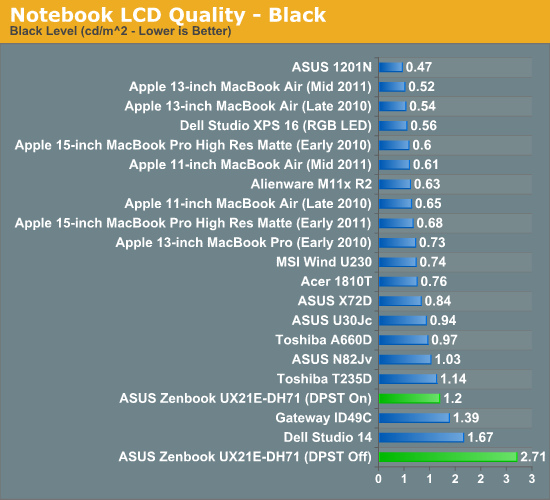
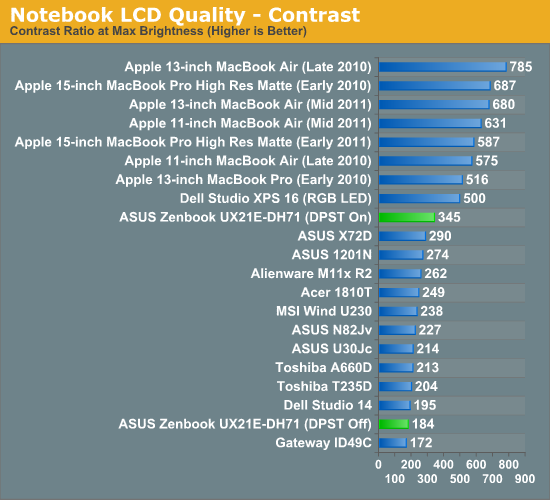
ASUS sent along test data that showed its black levels were only around 40% higher than the 11-inch MBA; however, after a couple of nights of trying I couldn't get any better than the numbers I've presented here. ASUS does use a more sophisticated colorimeter, but its test data for the MacBook Air seems to match up with mine whereas its Zenbook data is considerably better than what I have here.
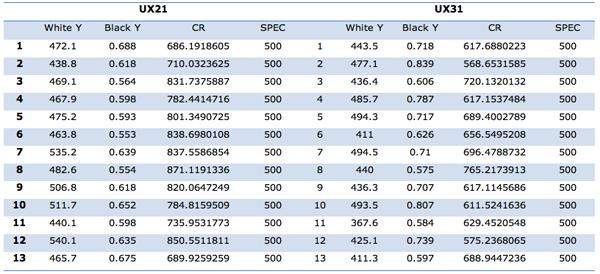
ASUS' Display Test Data

It's possible I simply received a bad unit, or perhaps I just lost the panel lottery with the UX21, but I can only report on the data I was able to generate. The Zenbook UX21's display is very bright, but it neeeds better black levels.
In terms of color quality and gamut, the Zenbook is very competitive once calibrated. You get better color gamut than a MacBook Air and comparable color accuracy. However, the out of the box calibration isn't all that great, as ASUS doesn't calibrate white to 6500K at the factory (it's set to 7700K by default). The system does ship with a digital color management system called Splendid, but you don't have many options beyond moving RGB or color temperature sliders. If ASUS wants to compete in this space I do believe it needs to calibrate panels at the factory.
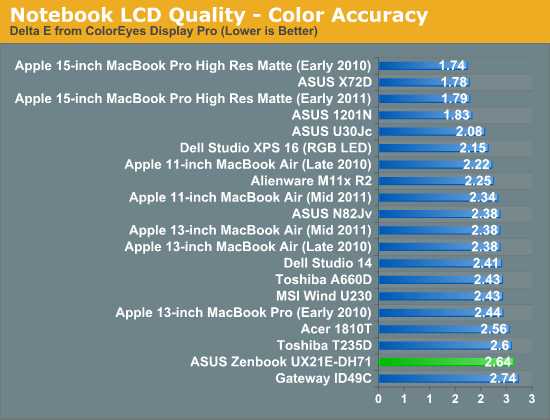
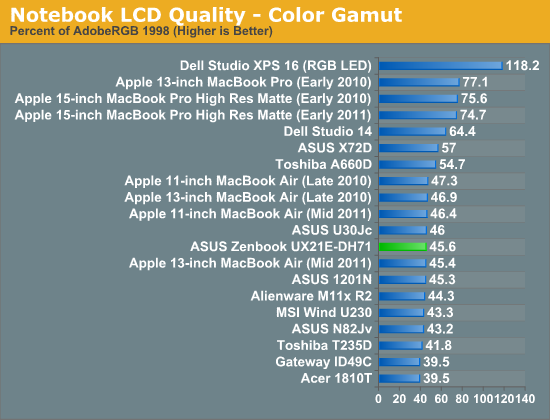
Viewing angle is my only other complaint about the UX21's panel. It seems as if in the quest for better specs, ASUS didn't pay enough attention to viewing angles. Although the UX21 uses a TN panel it is possible to improve viewing angle through the use of a compensation film in front of the polarizer in the display stack. Most TN panels are paired with some form of wide viewing angle film to improve their characteristics, but Apple actually uses an extra wide view compensation film in the case of the MacBook Air to give it slightly more IPS-like viewing angles. The downside to using this film is it reduces light output, which in turn improves black levels (peak contrast ratio is generally unaffected since you clip both white and black levels).
ASUS opted against using the same EWV film as Apple, in part to improve overall brightness as well as guarantee a little bit of off-angle privacy. While the result is a brighter display than what Apple was able to accomplish, the UX21 is far more sensitive to viewing angles. As you can see in the shots below, the UX21 looks great straight on but anything off center is significantly worse. In most situations I didn't find this to be a huge problem as I was able to tilt the display a little farther back and prevent the display from getting too washed out.
Overall the display is better than the vast majority of what you find on PC notebooks, however a couple of key decisions kept ASUS from making it perfect. I have already fed my test data and suggestions back to ASUS engineering, who are currently evaluating options for the second generation UX series next year.
















109 Comments
View All Comments
efeman - Saturday, October 22, 2011 - link
So, from what I can gather, it looks like a decent stab at a Windows-based true ultraportable. I'm excited to see the competition over the next few months, as well as what these things will evolve to over time.RussianSensation - Saturday, October 22, 2011 - link
If Asus fixes the track pad issue with firmware updates and does a Revision 2 when Ivy Bridge arrives, while keeping the same prices, this will be a viable competitor to the MacBook Air. It's a nice first stab at the Ultrabook market. However, I feel that when paying $1200-1400 for a 13.3 inch X31 model, the screen should be pretty nice. So I am going to have to skip this model until they fix the screen.DanNeely - Sunday, October 23, 2011 - link
I wouldn't hold my breath on the touchpad. My MSI wind netbook had a Sentilics pad; it was cripled by a few patents synaptics refused to license with anyone else.Friendly0Fire - Sunday, October 23, 2011 - link
Not that it matters much; Synaptics touchpads are also terrible. My Envy's is still barely usable a year after it came out.cloudgazer - Saturday, October 22, 2011 - link
On the battery life performance you have the Zenbook down as being an i5 - presumably that's a typo and was meant to be an i7? Or did you do the battery test on the i5 model? In which case the model number is presumably a typo?Something is squiffy at any rate.
JarredWalton - Saturday, October 22, 2011 - link
Corrected; it's the i7-2677M (there's no such thing as an i5-2677M, though there is an i5-2557M). Thanks.Filiprino - Saturday, October 22, 2011 - link
Now you are releasing 1600x900 thin laptops? GTH.And I can't believe that ASUS still puts b/g/n cards. Where are my 5Ghz frequencies?
vol7ron - Sunday, October 23, 2011 - link
I think Wireless-N (802.11n) uses both 2.4GHz and 5GHz frequencies.JarredWalton - Sunday, October 23, 2011 - link
802.11n can be 2.4GHz and/or 5GHz, but in this case ASUS used a cheaper chip that is 2.4GHz only. 802.11a/b/g/n usually means 5GHz is supported on 11n, but b/g/n typically means 2.4GHz only.vol7ron - Sunday, October 23, 2011 - link
I'm not sure that would meet N specs, though. You're saying it would operate w/ N, but it would be on a 2.4GHz band, which would more than likely limit the throughput.I think cards that are b/g/n, that only operate on 2.4GHz will still only see a max of 54Mbps, right?